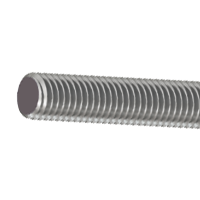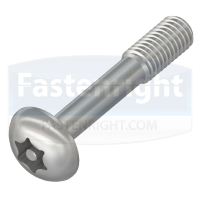This blog post was refreshed and updated on 29th October 2019.
Security Screws and other tamper-resistant fasteners are a great addition to any installation to prove extra levels of security. A suitable fastener needs to be picked for the job, otherwise, the fastener will not do its function correctly.
It is vital to use the exact size to ensure that the fastener fits, as if it is too big or small then it will be rendered useless and therefore will have wasted valuable time and money.
So, how do you measure security screws, and how do you ensure that the measurements you have made are accurate?
Screw Heads and Screw Length Measurements
The first thing to consider when measuring security screws is the head of the fastener as this will determine how to measure the screw itself.
Any fastener that has a raised head, that isn’t flush with the material that it is holding in place once fitted, is measured from the underside of the head to the tip of the screw.
A screw that has a flat or countersunk head is measured from the top of the head to the end.
A key factor to remember is that if the top of the screw sticks out from the material when in place, that extra length shouldn’t be counted in your measurement.
Measuring for Machine Security Screws
Machine Security Screws have a tamper-proof head that usually requires a specific tool to remove them. The shank of these types of screws is threaded from directly underneath the head to the tip, and it is this part that determines the measurement.
Each screw size is described using two numbers, the ‘M’ number signifies the diameter of the thread and the second number that stands for the length of the shank.
Most sizes are given in metric measurements, so the numbers given will refer to millimetres. For example, if you are looking for a machine security screw with a barrel diameter of 5mm and barrel length of 18mm, you would need an M5 x 18mm screw measurement. Here’s an example, Security Pin Hex cap screw.
Although metric measurements are most common, there is also the option available to order imperial sizes, so don’t be put off if you are unable to find the size you require in our product range.
Security Nut Measurements
Security Nuts need to be paired with a machine security screw, so their measurements will depend on the corresponding fastener.
To determine the correct size for the security nut, you will need to know the diameter of the screw thread. The diameter of the nut, i.e the ‘M’ number, should, therefore, match the ‘M’ number of the screw with which it will be paired. It is also important to ensure that you have the correct thread pitch, which is the distance between each thread. For example, an M8 x 1.25mm thread (standard) will not work with an M8 x 1mm thread (fine pitch).
If you are using a security barrel nut, you will need to know the length of the screw thread in addition to the diameter. Once you have the screw length, you will need to subtract the thickness of the material that the fastener and nut will be used on, to ensure that the nut barrel fits the screw securely.
Self-tapping Security Screw Gauges
Whilst millimetres are the most common unit of measurement for most types of screw, this is not the case for the self-tapping variety, where the diameter and length are measured using completely different units.
The length of the self-tapping screw is measured in imperial units; with the length given in inches and the diameter is given using the gauge measurement. This is difficult to measure without the appropriate tools, so we have coverted the gauge measurements for our self-tapping fasteners into millimetres to make measuring up for screws as simple as possible. Here’s an example, in our 2-hole pan self-tapping screw.
Need more help measuring up for screws?
Have a look at our security screw catalogue where you’ll see all of the standard sizes listed. If you are still unsure about how to find the right screw size for your requirements, or if you need a special size of screw, please contact us, our team will be happy to advise you.



